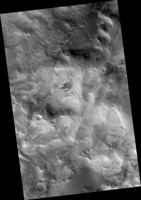
Map Projected Browse Image
Click on image for larger versionHiRISE has been imaging new dark features discovered by MRO's Context Camera, which are mostly new impact sites. In this scene we see what appears to be a new impact cluster and, extending downhill from the craters, new dark slope streaks.
These slope streaks are formed by dry dust avalanches. We've also seen large new dust avalanches associated with new impacts at previous locations.
The map is projected here at a scale of 25 centimeters (9.8 inches) per pixel. (The original image scale is 28.9 centimeters [11.4 inches] per pixel [with 1 x 1 binning]; objects on the order of 87 centimeters [34.3 inches] across are resolved.) North is up.
The University of Arizona, in Tucson, operates HiRISE, which was built by Ball Aerospace & Technologies Corp., in Boulder, Colorado. NASA's Jet Propulsion Laboratory, a division of Caltech in Pasadena, California, manages the Mars Reconnaissance Orbiter Project for NASA's Science Mission Directorate, Washington.

